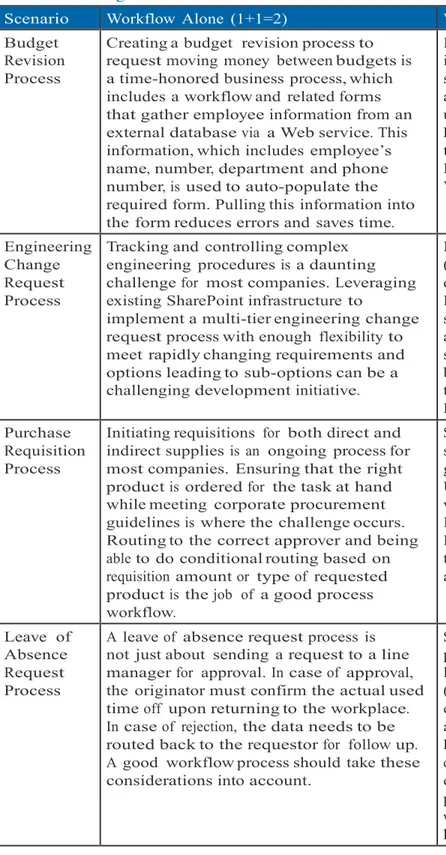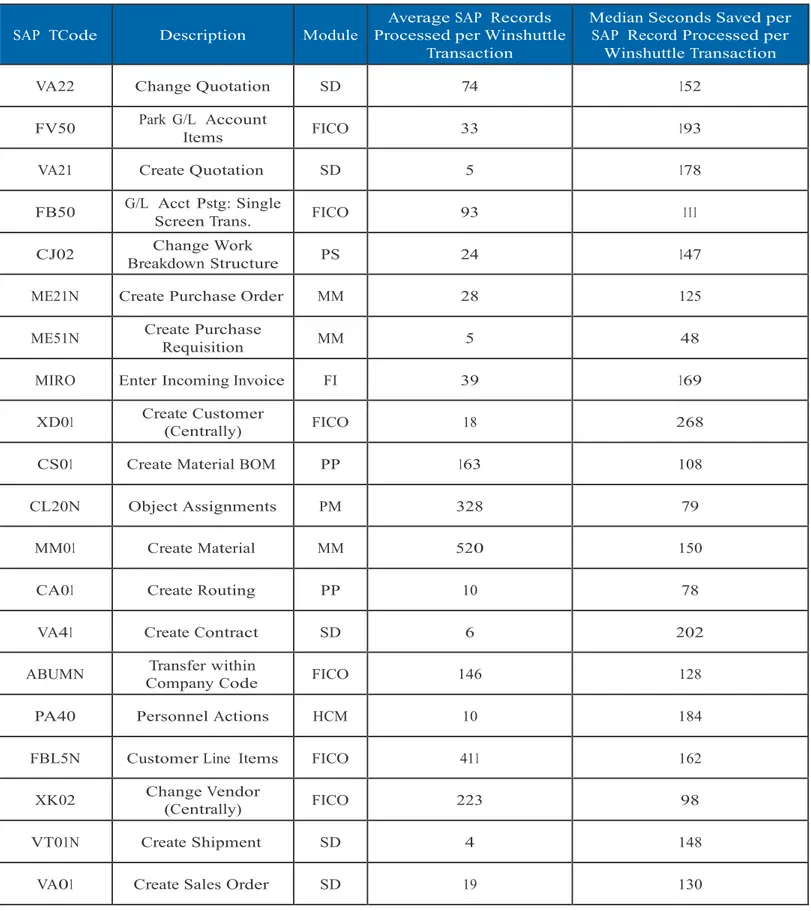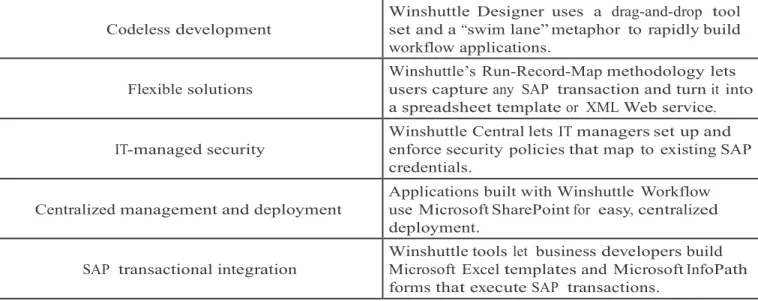Winning with SAP-Integrated
Workflow Solutions
Utilizing Business Developer Model to Increase Agility, Productivity and Value
Executive Summary
Agility is the key to survival in today’s marketplace. With swift technological advances and vast fluctuations in economic outlook, companies must continually adapt to new environments and find innovative ways to stay ahead of the competition.
A business developer model provides IT departments with the desired flexibility to meet growing business demands while maintaining core IT integrity. In this paradigm, non-IT
business developers are tasked with creating customized software solutions to advance business goals, thereby generating increased productivity and greater efficiency necessary for sustained success.
To maximize the value of this model, companies must empower business developers with user- friendly tools that allow for creation of effective workflow solutions without compromising IT security. While companies utilizing complex data-processing systems like SAP face an especially tough challenge in upgrading system usability, investing in effective solutions— such as those offered by Winshuttle—can enable business developers to build secure, SAP-integrated workflow applications that greatly increase corporate agility, productivity and value. This report discusses the requirements for successful implementation of the business
developer model and the advantages of creating comprehensive, SAP-based workflow solutions using Winshuttle tools.
Introduction
Ten years ago, mentioning the term “end-user developers” to an IT professional would elicit a response ranging from mere dismissal to quiet frustration or outright rage. Application development was serious business, and the bloated spreadsheets and rogue Web pages created by power users were at best a nuisance and at worst a liability. Advances in technology and the never-ending drive for competitive advantage have brought about a change in attitude, however, and many CIOs now regard enabling non- IT, non-professional developers to safely build and customize software applications as a component of an agile, business-driven IT department.
The term “non-professional developer” covers a wide range of individuals with varying levels of skill and sophistication. What they all have in common, though, is motivation: They just want to get a job done. Forrester Research defines the term “business developer” (1) as:
“a businessperson, not a professional application developer, who develops or configures an application to support business functions.”
This definition captures the source of these individuals’ value: their day-to-day participation in and
responsibility for business functions. It is this intimate connection to the business and the strong motivation to solve problems that allows a business developer to contribute to the organization’s success.
The Value of Empowering Business Developers
IT departments have embraced business developers partly out of recognition that these highly motivated individuals represent a novel solution to the existing problems. For years, IT departments tried to become more business-driven and business-relevant by trying to capture the expertise of line-of-business
employees and inject it into the application development process.
With business developers, the flow is reversed, allowing IT to align with business by providing tools and services to the line-of-business employees, who then build their own applications.
Business developers can also help IT solve the perennial problem of resource limitation. Shedding non- essential work enables IT to focus on core competencies and prevent technical expertise from being the limiting factor in determining what business goals can or can’t be pursued. As one writer put it, pushing application development into business units is just another form of outsourcing (2).
Empowering business developers can also raise an organization’s return on its IT investment by increasing the adoption and use of technology. Researchers at Idea Group Inc. found that users were more likely to use applications they had a role in developing (3). From this perspective, IT professionals frustrated by users’ refusal to adopt new, time-saving technologies may consider empowering business developers to employ such technologies to solve immediate problems, rather than simply conducting training on the use of pre-built solutions.
The Business Developer and SAP
Embracing business developers can ultimately help IT do more with less, but it does require investment. First and foremost, IT professionals must ensure that the activities of business developers are not a threat to the security and integrity of the organization’s data and infrastructure. Beyond that, forward- looking IT managers have begun to consider how to maximize the value of non-professional developers’
In a January 2011 report titled Empower the Business Developer, Forrester Research analyst Mike Gualtieri developed a set of best practices for IT organizations wishing to get the most out of the new model, as listed in Table 1.
Table 1: Best practices for empowering business developers (1)
1. Recognize business developers.
2. Establish a policy that defines how you will support businessperson development. 3. Create a “Should this be a businessperson-developed application?” checklist. 4. Make “businessperson-friendly” data sources and services available.
5. Help them overcome common hurdles.
6. Adopt tools with caution.
7. Collect and broadcast best practices for businessperson development.
Item 4 on this list highlights a dilemma for organizations that have deployed Enterprise Resource Planning (ERP) software like SAP as their system of record. The data and processes that matter most to the business operations of these companies are stored in SAP. However, the development tools
for building SAP applications are far beyond most business developers’ capabilities, and the cost of mistakes is too high. Making SAP data and services “businessperson-friendly” is a tall order, and one that many companies simply reject out of hand.
Declaring SAP off limits to business-driven development efforts is a major lost opportunity, however. For many companies, SAP is no longer just “back-office” software, handling complex processes limited to a small number of experts. SAP is the pivotal process component in sales, HR, plant maintenance and other employee- and customer-intensive functions. These are precisely the areas where business developers can have the most impact. Denying business developers access to SAP data and processes creates a business automation “no man’s land” that limits both the potential effectiveness of business developers and the potential return on SAP investment.
The Case for Workflow
For organizations that recognize the value of allowing business developers to use SAP data and processes, workflow applications are a good place to start.
First, workflow applications possess several characteristics well-suited for business developers: People-intensive: Workflow applications formalize and automate interactions among people in the workplace. Business developers who are part of these interactions possess both first-hand knowledge of how they work and a strong motivation to see them work more effectively and efficiently.
Limited in scope: A workflow application’s job is generally limited to routing information to the right person and presenting that person with a limited set of choices. The complex work of analysis and decision-making is left to the person and does not need to be captured in code.
Familiar: Anyone who has worked in a company has probably designed a workflow, even if the tools used were limited to email or interoffice mail. Thus, most business developers find workflow concepts familiar and intuitive.
Second, the incremental value of adding SAP data and processes to workflow applications is high. Workflow applications that cannot perform data operations are rarely a complete solution. They may capture approval for an action, for example, but not execute the action itself, which must be performed manually. In the case of a SAP data operation, that manual step must be performed by someone with
Giving business developers the ability to build workflow applications that perform data operations increases the value of their work and extends the ability of SAP to automate business processes further out into the organization. Several common examples are illustrated in Table 2.
Table 2: Increasing value with SAP-based workflow
Scenario Workflow Alone (1+1=2) Workflow + SAP (1+1=3) Budget
Revision Process
Creating a budget revision process to request moving money between budgets is a time-honored business process, which includes a workflow and related forms that gather employee information from an external database via a Web service. This information, which includes employee’s name, number, department and phone number, is used to auto-populate the required form. Pulling this information into the form reduces errors and saves time.
Leveraging the same workflow plus SAP integration would result in the ability to pull specific cost centers, compare budget vs. actual data for prior year, and revise figures by uploading data back to SAP, using a specific FICO transaction code. Example SAP budget transaction codes would include IM52 (Process Budget Distribution), FMBB (Budgeting
Workbench) and KO22 (Change Order Budget).
Engineering Change Request Process
Tracking and controlling complex engineering procedures is a daunting challenge for most companies. Leveraging existing SharePoint infrastructure to
implement a multi-tier engineering change request process with enough flexibility to meet rapidly changing requirements and options leading to sub-options can be a challenging development initiative.
Extending the engineering change request (ECR) process to SAP takes workflow complexity to another level. Integrating with Production Planning and specific transactions, such as CC23, CC31, CC32 (Create, Change and Display Request, respectively), via a Web- services interface provides the value of a SAP- based, single trusted source of information with the accountability and auditability of a good ECR process workflow.
Purchase Requisition Process
Initiating requisitions for both direct and indirect supplies is an ongoing process for most companies. Ensuring that the right product is ordered for the task at hand while meeting corporate procurement guidelines is where the challenge occurs. Routing to the correct approver and being able to do conditional routing based on requisition amount or type of requested product is the job of a good process workflow.
SAP Material Management is a world-class solution for managing the acquisition of goods and services to companies worldwide. Using Web services to integrate configurable workflow with the SAP ME51N (Create Purchase Requisition) and ME52N (Change Purchase Requisition) is a good example of leveraging the SharePoint infrastructure for business-user- authored SAP process innovations.
Leave of Absence Request Process
A leave of absence request process is not just about sending a request to a line manager for approval. In case of approval, the originator must confirm the actual used time off upon returning to the workplace. In case of rejection, the data needs to be routed back to the requestor for follow up. A good workflow process should take these considerations into account.
SAP Human Capital Management (HCM) provides an array of options for managing leave of absence requests, including PA30
(Infotype 2006—Leave Entitlement). Integrating externalized leave of absence process workflow in a SharePoint environment and into a SAP
HCM environment brings together the best of both worlds—a business-friendly authoring environment with SharePoint as a deployment platform and easy-to-use authoring tools, as well as a world-class system of record and time- honored governance and security framework.
Requirements for a Solution
The challenge for organizations is to find a solution that would allow business developers to build workflow applications that can perform SAP data operations while maintaining IT security and integrity. More specifically, such a solution must meet the following requirements:
• Codeless development: Tools for business developers must be easy to use. The barrier to entry for a tool that requires even simple scripting is substantial and sharply reduces the number of people who can use it. Codeless development is not just about the ease of use, however; it is about the safety and security of the application. Poorly written custom code, lack of supporting technical documentation and no version management can wreak havoc on a system. Tools that use drag-and-drop, macro-recording and similar paradigms are not just easier for business developers to use; they also reduce the likelihood of buggy applications that can slow down system performance, or worse.
• Flexible solutions: Many solutions use a model that requires professional developers to build templates, parts or apps that non-developers can then customize. This is not the business developer model. Business developers must have the flexibility to innovate and pursue novel solutions. If they have to run to IT every time an unexpected scenario arises, then the bottleneck has simply been moved, not eliminated. The value of business developers is their ability to rapidly respond to changing business conditions, and that value is sharply limited if they are over-reliant on intermediaries.
• IT-managed security: Opinions differ on where IT should draw the line for business developers, but one thing is certain—IT must maintain control of security. In the case of SAP, business developers should only have access to data and functionality that they can access as users. While this will limit the scope of applications they can develop, it is consistent with the philosophy that business developers should only build applications directly relevant to their roles and responsibilities in the business.
• Centralized deployment and management: Business developers must be able to easily deploy and update their applications, and IT must be able to maintain an accurate inventory of what is deployed in their organization. Ideally, the tools used to build business developer applications should be tightly integrated with a corporate portal or other managed network environment.
• SAP transactional integration: To fully realize the power of the business developer model, organizations must expose SAP data and processes as resources for non-developers to use. It is not enough to provide read-only access to data, for example. To fully automate business processes, workflow applications must be able to execute SAP transactions and perform SAP data operations.
Giving business developers the right tools to create workflow applications that integrate with SAP can
extend the benefits of business automation deeper into the organization without compromising IT security or control.
The Winshuttle Workflow Advantage
In business since 2003 and with over 1,500 customers worldwide, Winshuttle is the leading developer of effective solutions that improve SAP usability and help organizations get the most out of their SAP
investment. Data from existing Winshuttle customers consistently demonstrates that giving users the ability to use familiar tools like Microsoft Excel to enter and query SAP data results in dramatic improvements in speed, efficiency and accuracy across a wide range of functional areas. A partial list of the data analyzed to date is provided in Table 3.
Table 3: Top SAP Transactions for potential process improvements
(To project potential capacity gains, multiply estimated records processed by the median seconds saved.)
SAP TCode Description Module
Average SAP Records Processed per Winshuttle
Transaction
Median Seconds Saved per SAP Record Processed per
Winshuttle Transaction
VA22 Change Quotation SD 74 152
FV50 Park G/L Account
Items FICO 33 193
VA21 Create Quotation SD 5 178
FB50 G/L Acct Pstg: Single
Screen Trans. FICO 93 111
CJ02 Change Work
Breakdown Structure PS 24 147
ME21N Create Purchase Order MM 28 125
ME51N Create Purchase
Requisition MM 5 48
MIRO Enter Incoming Invoice FI 39 169
XD01 Create Customer
(Centrally) FICO 18 268
CS01 Create Material BOM PP 163 108
CL20N Object Assignments PM 328 79
MM01 Create Material MM 520 150
CA01 Create Routing PP 10 78
VA41 Create Contract SD 6 202
ABUMN Transfer within
Company Code FICO 146 128
PA40 Personnel Actions HCM 10 184
FBL5N Customer Line Items FICO 411 162
XK02 Change Vendor
(Centrally) FICO 223 98
VT01N Create Shipment SD 4 148
Winshuttle Workflow and Winshuttle Designer allow business developers to integrate easy-to-use Winshuttle tools and Microsoft SharePoint to rapidly build innovative workflow solutions that perform SAP data operations. This business developer solution also satisfies IT requirements for security and control, as shown in Table 4.
Table 4: Winshuttle tools and business developer requirements
Codeless development
Winshuttle Designer uses a drag-and-drop tool set and a “swim lane” metaphor to rapidly build workflow applications.
Flexible solutions
Winshuttle’s Run-Record-Map methodology lets users capture any SAP transaction and turn it into a spreadsheet template or XML Web service. IT-managed security
Winshuttle Central lets IT managers set up and enforce security policies that map to existing SAP credentials.
Centralized management and deployment
Applications built with Winshuttle Workflow use Microsoft SharePoint for easy, centralized deployment.
SAP transactional integration
Winshuttle tools let business developers build Microsoft Excel templates and Microsoft InfoPath forms that execute SAP transactions.
With rapid technological advances and increased focus on streamlined productivity in recent years, organizations have begun to embrace business developers as valued contributors of agile, business- driven IT. Business developers can increase enterprise-wide adoption of technology, enhance productivity and enrich innovation.
Effective implementation of the business developer model requires a user-friendly platform that does not compromise core IT integrity. Usability enhancements are especially critical for companies that utilize complex data-processing systems like SAP. Providing appropriate tools and allowing non-IT
developers to build workflow applications that perform SAP data operations can increase both the value of the business developer model and the return on SAP investment.
Winshuttle’s innovative solutions let business developers build high-value, SAP-integrated workflow applications without sacrificing IT security and control.
For more information about how Winshuttle can help your company empower business developers and get the most out of your SAP investment, visit www.winshuttle.com or email info@winshuttle.com.
Bibliography
1. Gualtieri, Mike. Empowering the “Business Developer.” Boston: Forrester Research, 2011.
2. Driver, Mark. Characteristics and Best Practices of Business Unit Application Development. Stamford: Gartner, 2011.
3. McGill, Tanya. The Effect of End User Development on End User Success. Hershey: Idea Group Publichsing, 2005.
Theresa Ciacchi
Senior Account Executive - Business Solutions Group 118 W. Streetsboro Rd. Suite 221, Hudson, OH 44236 p. (440) 580-4668 c. (440) 487-7821 e. tciacchi@adaptivecorp.com



